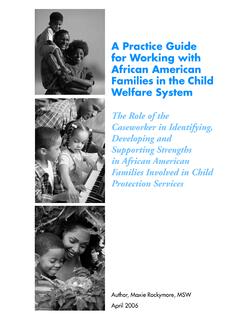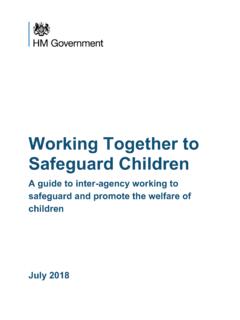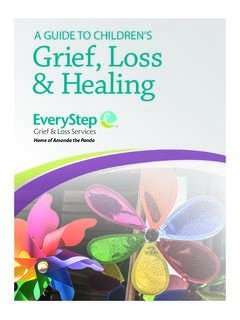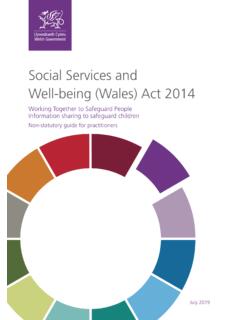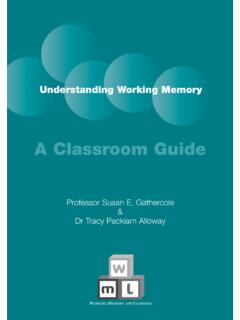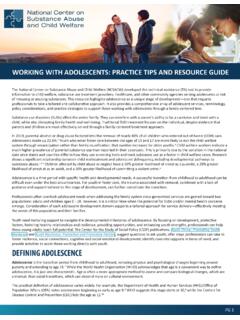Transcription of Guide to the Children’s Homes Regulations including the ...
1 Guide to the children s Homes Regulations including the quality standards April 2015 2 Contents Introduction 4 Who is this Guide for? 4 The regulatory framework and legal status of this Guide 5 Who is accountable for meeting the Regulations and information contained in the Guide ? 5 Principles for residential child care 5 The diversity of children s Homes settings 6 About the Quality Standards 7 How this Guide works 8 Inspection 8 Other matters 9 The Quality Standards 10 Regulation 5 - engaging with the wider system to ensure children s needs are met 10 The quality and purpose of care standard 13 The children s views, wishes and feelings standard 20 The education standard 25 The enjoyment and achievement standard 30 The health and well-being standard 32 The positive relationships standard 37 The protection of children standard 41 The leadership and management standard 51 The care planning standard 55 Management and administrative Regulations 60 Guidance on Chapter 3 of the Regulations Registered persons 60 Guidance on Chapter 4 of the Regulations Staffing 61 3 Guidance on Chapter 5 of the Regulations Policies, records.
2 Complaints and notifications 61 Guidance on Part 6 of the Regulations Monitoring and reviewing children s Homes 64 Explanation of terms 67 ANNEX A Qualifications for staff working in children s Homes 68 Manager Qualifications 68 Staff Qualifications 71 ANNEX B Additional information for secure children s Homes 72 4 Introduction children s Homes provide support and care for some of our most vulnerable children and young people. We want each child in care to be provided with the right placement at the right time, and for residential child care to be a positive and beneficial choice for the children and young people living in children s Homes . This Guide accompanies the children s Homes (England) Regulations 2015 ( the Regulations ). It provides further explanation and information for everyone providing residential child care.
3 The Regulations include Quality Standards which set out the aspirational and positive outcomes that we expect homes1 to achieve. They also set out the underpinning requirements that Homes must meet in order to achieve those overarching outcomes. Many children placed in residential child care will have highly complex and challenging needs. Their abilities and individual stage of development will determine their starting point when they arrive at the children s home and the home may need to support them through a complex and extended period of transition before they are able to positively engage and develop. This should not limit the home s ambitions for each child. The requirements within the Regulations and the information in this Guide should be interpreted and applied in the context of each child s individual needs.
4 Who is this Guide for? This Guide is for all those involved with the care of children (and in some cases those aged 18 or over (regulation 1(2)(b))) in children s Homes and particularly those who are subject to the Regulations . Key settings subject to the Regulations are: children s Homes ; children s Homes that provide short break care; Secure children s Homes ; and Residential special schools or boarding schools who accommodate children for more than 295 days per year. Some Regulations have been modified or do not apply to children s Homes that provide short break care or secure children s Homes . Detail about any modifications to the Regulations , or Regulations that do not apply, appear at the end of the relevant section in this Guide and are set out in regulation 52 and schedule 5 of the Regulations .
5 1 The term home or Homes is used in the widest sense and includes, but is not limited to, those working in the children s home , and the organisation who runs the children s home . 5 The regulatory framework and legal status of this Guide This Guide is a statement published pursuant to section 23 of the Care Standards Act 2000 ( the 2000 Act ). It explains and supplements the Regulations (see section 23(1A) of the 2000 Act). It provides explanations of: terms used in the Regulations ; what is expected for the various requirements of the Regulations to be met and signposts some of the relevant statutory and non-statutory guidance. The registered person (see paragraph ) must have regard to this Guide in interpreting and meeting the Regulations (regulation 15).
6 Ofsted must also have regard to this Guide in regulating children s Homes . Who is accountable for meeting the Regulations and information contained in the Guide ? Most of the Regulations are drafted to make the registered person accountable this means the registered provider or registered manager depending on how the home is organised, run and managed. The language of the Guide follows this approach. Principles for residential child care The principles upon which residential child care is delivered are important elements that underpin the Regulations and this Guide . The principles below, originally drafted by NCERRC2, have been amended for use in this document following contributions before and during our consultation period by the residential child care sector.
7 We would expect all Homes to apply the principles below, and to ensure that residential child care is a positive choice for children and young people where a children s home is the best placement to meet their individual needs. 2 National Centre for Excellence in Residential Child Care 6 The diversity of children s Homes settings children s Homes provide care for children and young people with a wide range of needs in a diverse range of settings. The regulatory framework sets out high ambitions for all children living in children s Homes , but recognises the acute differences between vulnerable adolescents who have had traumatic life experiences and children with complex special educational needs. With this in mind, it is important that registered persons meet the Regulations having regard to the needs of children placed in the home and the role and aims of the home as set out in their Statement of Purpose.
8 This Guide identifies specific Regulations Residential child care key principles children in residential child care should be loved, happy, healthy, safe from harm and able to develop, thrive and fulfil their potential. Residential child care should value and nurture each child as an individual with talents, strengths and capabilities that can develop over time. Residential child care should foster positive relationships, encouraging strong bonds between children and staff in the home on the basis of jointly undertaken activities, shared daily life, domestic and non-domestic routines and established boundaries of acceptable behaviour. Residential child care should be ambitious, nurturing children s school learning and out-of-school learning and their ambitions for their future.
9 Residential child care should be attentive to children s need, supporting emotional, mental and physical health needs, including repairing earlier damage to self-esteem and encouraging friendships. Residential child care should be outward facing, working with the wider system of professionals for each child, and with children s families and communities of origin to sustain links and understand past problems. Residential child care should have high expectations of staff as committed members of a team, as decision makers and as activity leaders. In support of this, children s Homes should ensure all staff and managers are engaged in on-going learning about their role and the children and families they work with. Residential child care should provide a safe and stimulating environment in high-quality buildings, with spaces that support nurture and allow privacy as well as common spaces and spaces to be active.
10 7 where a home s approach may need to be different because of the purpose of the home and/or the needs of the children they care for. About the Quality Standards The Regulations set out standards ( the Quality Standards ) that must be met by Homes . The Quality Standards describe outcomes that each child must be supported to achieve while living in the children s home . Each contains an over-arching, aspirational, child-focused outcome statement, followed by a non-exhaustive set of underpinning, measurable requirements that Homes must achieve in meeting each standard. The Regulations prescribe nine Quality Standards which must be met by children s Homes : 1. The quality and purpose of care standard (see regulation 6) 2. The children s views, wishes and feelings standard (see regulation 7) 3.










